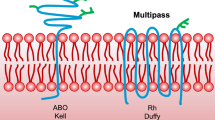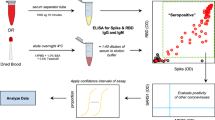Abstract
THE sera of two women, whose babies were suspected of suffering from hæmolytic disease of the new-born, were recently found to contain identical agglutinins of a variety not previously described. The serological examination of the two families is at present incomplete, but there is so far no definite evidence in either case that the agglutinin concerned is the result of immunization of the mother by the fœtus. Indeed, the red cells of one of the jaundiced babies were not agglutinated by its mother's serum: this points towards the agglutinin being spontaneous rather than immune.
This is a preview of subscription content, access via your institution
Access options
Subscribe to this journal
Receive 51 print issues and online access
$199.00 per year
only $3.90 per issue
Buy this article
- Purchase on SpringerLink
- Instant access to full article PDF
Prices may be subject to local taxes which are calculated during checkout
Similar content being viewed by others
References
Callendar, Race and Paykoc, Brit. Med. J., ii, 83 (1945).
Coombs, Mourant and Race, Lancet, i, 264 (1946).
Coombs, Mourant and Race, Brit. J. Exp. Path., 26, 255 (1945).
Author information
Authors and Affiliations
Rights and permissions
About this article
Cite this article
MOURANT, A. A ‘New’ Human Blood Group Antigen of Frequent Occurrence. Nature 158, 237–238 (1946). https://doi.org/10.1038/158237c0
Issue date:
DOI: https://doi.org/10.1038/158237c0
This article is cited by
-
Lewis and AB0 blood group-phenotypes in periodontitis, cardiovascular disease, obesity and stroke
Scientific Reports (2019)
-
Observations on the Lewisa and Lewisb activity of erythrocytes
International Journal of Legal Medicine (1995)
-
Expression of Lewis histo-blood group glycolipids in the plasma of individuals of Le(a+b+) and partial secretor phenotypes
Glycoconjugate Journal (1994)



